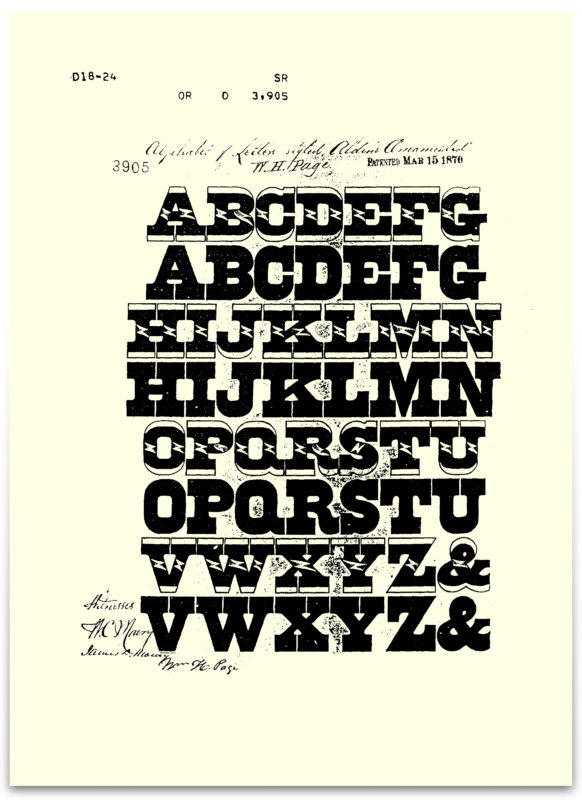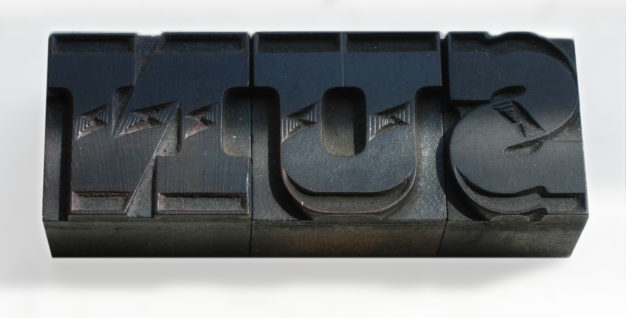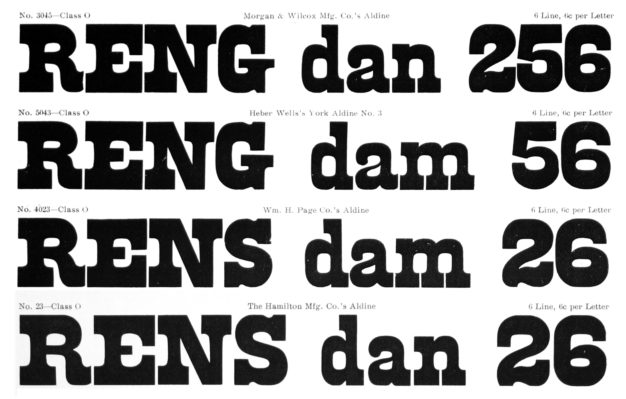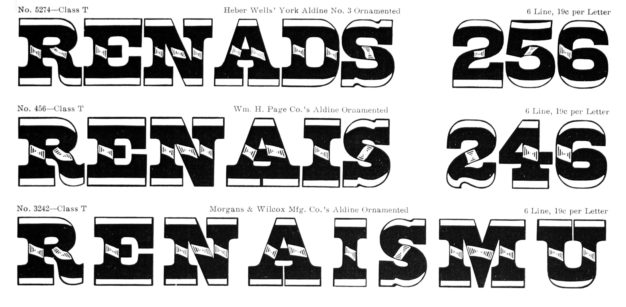Aldine & Aldine Ornamented
by David Shields. Average Reading Time: about 3 minutes.
Aldine & Aldine Ornamented were patented by William H Page — and assigned to William H Page & Co — on March 15, 1870, (US Design No 3,905). The plain face Aldine was first shown April 1870, in Marder, Luce & Co’s quarterly The Chicago Specimen{1}. Both Aldine and Aldine Ornamented were shown by William H Page & Co in their July 1870 Specimens of Wood Type.
In American Wood Type Rob Roy Kelly{2} stated that he believed this design to have originated as a wood type in America. Kelly showed specimens of these faces on pages 265 and 266 of American Wood Type.
Aldine was a low contrast modification of the Clarendon style letter set to squarer proportions. Clarendons are themselves a variation of the Antique style in which the serifs are bracketed with a soft transition at the stroke joints and tend to exhibit higher contrast between thick and thin strokes{3}. The Clarendon style was immensely popular during the second half of the nineteenth century and was elaborated into a wide range of designs.
Examination of samples of actual type blocks of Aldine Ornamented in the Rob Roy Kelly American Wood Type Collection at The University of Texas at Austin indicates that, while the face was cut on the router-pantograph, the delicate filigree detail at the midsection of the face was finished by hand.
Page first showed Aldine and Aldine Ornamented in the catalog Specimens of Wood Type from July 1870. In this catalog, Aldine was listed in price Class B, and Aldine Ornamented was listed in Class E. Both faces were also shown in Page catalogs from August 1872, July 1873, September 1876, 1880. Aldine was shown in 1885 and 1888, while Aldine Ornamented was only shown again in 1887. Page never showed a lowercase for Aldine Ornamented but did show a lowercase for Aldine in the 1885 Wood Type, Borders, &c.
Text in the patent application indicates Page designed this face to be used both individually and chromatically. “…the two alphabets to be printed single, or the one printed over the other in colors.” The design was shown chromatically in both the July 1870 catalog as well as 1874 Specimens of Chromatic Wood Type, Borders, &c listed as Chromatic Aldine Ornamented.
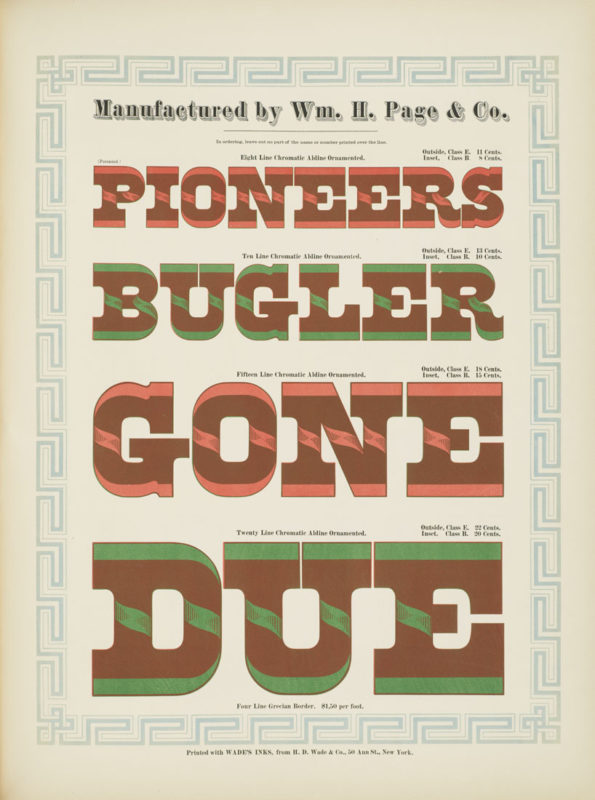
Wm. H. Page & Co. Specimens of chromatic wood type, borders, etc. manufactured by Wm. H. Page & Co. Greeneville, Conn. : The Co., 1874. Electronic reproduction. New York, N.Y. : Columbia University Libraries, 2013. NNC. Columbia University Libraries Electronic Books. 2006.
It does seem from the known printed catalog record that, though Page patented the design, other manufacturers also produced subtle variations after at least 1872. Almost all competitors used the name Aldine. Hamilton named their version Aldine and also used the name No 23; Morgans & Wilcox named their version Aldine, renamed No 3045 by Hamilton after the 1897 acquisition; National Printers’ Materials named their version Aldine; Tubbs named their version Aldine and later No 2167; Vanderburgh, Wells & Co used the name York Aldine No 3, Heber Wells then renamed the face No 496 in 1890 after taking sole control of the company, and it was renamed No 5043 by Hamilton after the 1899 acquisition. Hamilton renamed the Page cut of Aldine, No 4023 after the 1891 acquisition.
Several manufacturers also produced their own subtle variations of Aldine Ornamented. Hamilton only offered Aldine Ornamented — renamed No 456 — after the 1891 acquisition of Page’s wood type company. Morgans & Wilcox showed a version of Aldine Ornamented, which was renamed No 3242 by Hamilton after the 1897 acquisition; and Wells showed the face as York Aldine No 3 Ornamented, which was renamed No 5274 by Hamilton after the 1899 acquisition. The face doesn’t appear in the specimen record after Hamilton’s eponymous Catalog No 16 of 1906.
__________- Marder, Luce & Co. The Chicago Specimen 4, no. 2 (April, 1870). [↩]
- Kelly, Rob Roy. American Wood Type: 1828–1900, Notes on the Evolution of Decorated and Large Types and Comments on Related Trades of the Period. New York: Van Nostrand Reinhold Company, 1969: 265, 266. [↩]
- The first bracketed Antique shown typographically was by the English foundry Blake & Stephenson, in 1833, and named Ionic. This name would be used for this bracketed style until 1845 when Robert Besley registered a heavier design with higher stroke contrast named Clarendon. [↩]

